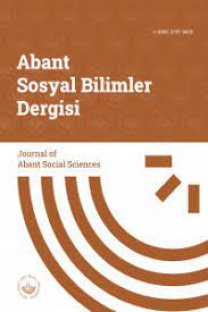LİDERLİK TÜRLERİNİN ÖRGÜTSEL PERFORMANS ÜZERİNE ETKİSİNDE YÖNETİM TARZININ ARACILIK ROLÜ
Liderlik türleri, Örgütsel performans, Yönetim tarzı, Çok Faktörlü Liderlik Ölçeği
THE EFFECT OF LEADERSHIP TYPES ON ORGANIZATIONAL PERFORMANCE AND THE MEDIATING ROLE OF MANAGEMENT STYLE
Types of Leadership, Company Performance, Management Style, Multifactor Leadership Questionnaire,
___
- Alice H. Eagly (2007), “Female Leadership Advantage And Disadvantage: Resolving The Contradictions Psychology of Women Quarterly”, 31 pp1–12.
- Bart A.G. Bossink, (2004) "Effectiveness of innovation leadership styles: a manager’s influence on ecological innovation in construction projects", Construction Innovation, Vol. 4 Issue: 4, pp.211-228
- Baskarada, S.,J.Watson, J.Cromarty, (2017), “Balancing Transactional and Transformational Leadership”, International Journal of Organizational Analysis, Vol.25, No.3, pp.506-515.
- Bass, B. M., B.J. Avolio, (2007), “Developing Transformational Leadership: 1992 and Beyond”, Journal of European Industrial Training. Vol.14, Issue 5.
- Bassem E.Maamari and Joelle F.Majdalani,(2017) “Emotional intelligence, leadership style and organizational climate”, International Journal of Organizational Analysis Vol.25 No.2, pp.327-345
- Birasnav,M.(2014),“Relationship between transformational leadership behavior sand manufacturing strategy”, International Journal of Organizational Analysis, Vol. 22 No. 2, pp. 205-223.
- Ercan, Ü., Ü Sığrı, Eylül 2015, “ The Effect of Cultural Values on Leadership Behavior: A research on Turkish and American Managers” , Journal of Public Administration C:8, S:3, s.95-126.
- Jui‐Chen Chen, Colin Silverthorne, (2005) "Leadership effectiveness, leadership style and employee readiness", Leadership & Organization Development Journal, Vol. 26 Issue: 4, pp.280-288
- Kaplan, R., Norton, D., 1996, Balanced Scorecard, (Translate: Serra Egeli, Sistem Publication, 1999, İstanbul)
- Meydan, C.H., H. Şeşen, (2015), Structural Equation Modeling Amos Applications, Detay Publication, Ankara.
- Mittal,S.and Dhar,R.L.(2015),“Transformational leadership and employee creativity:mediatingrole of creative self-efficacy and moderating role of knowledge sharing”, Management Decision, Vol.53No.5,pp.894-910.
- Özgür, B., 2011, “Management Style and its Effects”, Journal of Evenue, Sayı.161, ss.215-230
- Rohmann, A., J. Rowold, 2009, “Gender and Leadership Style”, Equal Opportunities International, Vol.28, No.7, pp. 545-560.
- S. El Masry , H. Kattara & J.El Demerdash, (2004), “A Comparative Study on Leadership Styles Adopted by General Managers: A Case Study in Egypt Anatolia” An International Journal of Tourism and Hospitality Research Volume 15. Number 2, pp. 109-124 2004 Copyright O 2004 Anatolia Printed in Turkey. All rights resewed 1303-2917104 $20.00 + 0.00
- Torres, J.P.,Drago, C. and Aqueveque, C. (2015), “Knowledge inflows effects on middle managers’ ambidexterity and performance”, Management Decision, Vol. 53 No. 10, pp. 2303-2320.
- Vera, D. and Crossan, M.(2004),“Strategic leadership and organizational learning”, Academy of Management Review, Vol. 29 No. 2, pp. 222-240.
- VonKrogh,G.,Nonaka,I.andRechsteiner,L.(2012),“Leadershipinorganizationalknowledge creation: a review and framework”, Journal of Management Studies, Vol. 49 No. 1, pp. 240-277.
- Xu, L., Z. Wulbena, T.Stewart, (2016),“Measurement invariance of second-order factor model of the Multifactor Leadership Questionnaire (MLQ) across K-12 principal gender”, Journal of Educational Administration Vol. 54 No. 6, pp. 727-748.
- Yukl,G.(2012),“Effective leadership behavior:what we know and what questions need more attention”, The Academy of Management Perspectives, Vol. 26 No. 4, pp. 66-85.
- Zuned, Al A. M., April 2017, “Effective Business Leadership Styles: A case study of Harriet Green”, Middle East Journal of Business – volume 12, İssue. 2.
- Yayın Aralığı: Yılda 3 Sayı
- Başlangıç: 2000
- Yayıncı: Abant İzzet Baysal Üniversitesi Sosyal Bilimler Enstitüsü
OPTİMAL PORTFÖY SEÇİMİNDE BULANIK ORTALAMA MUTLAK SAPMA MODELİ VE BİST 30 UYGULAMASI
GÖYNÜKLÜ BİR TARİH YAZICISI: ŞIKK-I SANİ DEFTERDARI VE HAZİNE-İ BİRUN KÂTİBİ AHMED BİN MAHMUD EFENDİ
EKONOMİK BÜYÜME VE NİTELİK UYARLANMIŞ BEŞERÎ SERMAYE İLİŞKİSİ: 1976-2013 PANEL VERİ ÇALIŞMASI
FOTO SAFARİ ETKİNLİĞİNE KATILAN BİREYLERİN TURİZM DENEYİMLERİNİN DAVRANIŞSAL NİYETE ETKİSİ
LİDERLİK TÜRLERİNİN ÖRGÜTSEL PERFORMANS ÜZERİNE ETKİSİNDE YÖNETİM TARZININ ARACILIK ROLÜ
Cengiz YILMAZ, Nilüfer YÖRÜK KARAKILIÇ
TOPLUMSAL KİMLİK OKURYAZARLIĞI
BÖLGESEL KALKINMADA SOSYAL SERMAYENİN ROLÜ: ZONGULDAK’TA BİR ALAN ARAŞTIRMASI
Hamza ÇEŞTEPE, Alican GEMİCİOĞLU
Banu KÜÇÜKSARAÇ, Hakan KÜÇÜKSARAÇ
BANKA KÂRLILIĞINA ETKİ EDEN MİKRO DEĞİŞKENLER: TÜRK BANKACILIK SEKTÖRÜ ÜZERİNE BİR ARAŞTIRMA
MERKEZ BANKASI DİJİTAL PARASI VE PARA POLİTİKASINA YANSIMALARI
